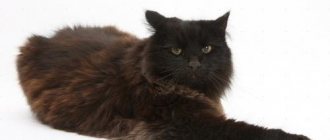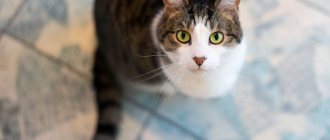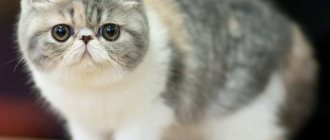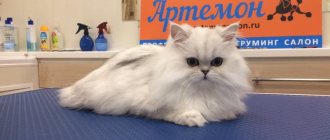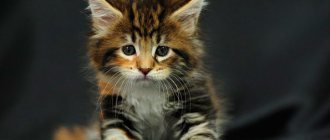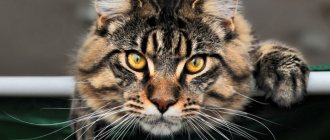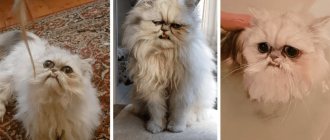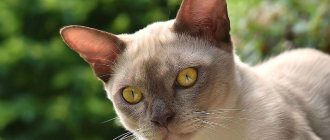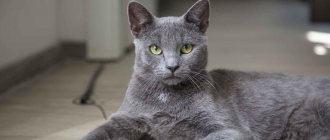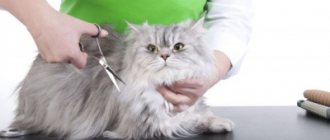For every cat owner, a source of pride is its shiny and beautiful coat. As soon as the cat begins to actively lose its fur, spreading its fur throughout the apartment, especially when the cat's shedding is prolonged, the owners begin to worry. And the cause of concern is not only frequent wet cleaning in the apartment due to the large amount of cat hair, but also whether your pet is sick.
Is shedding normal in a cat or is it one of the symptoms of some disease?
Seasonal shedding. Molting is inherent in all living beings. A cat living in a city apartment is no exception. In the spring, cats change their “coat” in accordance with the growing warmth in nature, and in the fall, with the approach of cold weather, that is, the cat’s owners observe the process of losing and growing new hair. During shedding, the cat behaves as usual, its appetite is preserved, and it does not outwardly look sick. When a cat sheds, it leaves behind a large amount of fur. To keep your pet's coat smooth and fluffy during shedding, try to choose the highest quality premium food. Brush your cat regularly using special brushes and combs. In cats living in city apartments, shedding can last from 2 to 3 months.
Apartment molt . Cats living in an apartment shed all year round, despite good nutrition, absolute health and quality care. Such cats practically do not feel the change of seasons: the molting period in indoor cats stretches for several months, or even the whole year. Indoor shedding intensifies in winter, when the heating starts working in the house or apartment, and the drier the air in the room, the stronger the cat’s shedding. Air conditioners, air humidifiers, and even simple aquariums can partially help owners cope with indoor shedding. For such a cat, owners need to choose suitable food and professional hygiene products (shampoo, conditioner, nourishing masks). Anti-shedding vitamins for cats are effective, but they should not be abused - a maximum of two monthly courses per year.
Baby shedding is the process of changing a kitten's fur to adult fur. Kittens begin to shed at 6 months of age. Molting in kittens continues for 1-2 months. Coarser adult hair grows back, which is thicker and heavier than baby fur. At the same time, the patterned kittens become brighter - the ghostly haze disappears, and the slight fading of the fur, necessary for camouflaging the young, disappears. The dark areas of the skin of Siamese and Burmese become brighter and richer. During a child's coat change, no remedy for shedding cats will help; the owner can only comb the coat daily and make sure that the baby is fed well. The better the living conditions, the faster the coat will change and the more beautiful the adult coat will be.
Pregnancy and feeding kittens . Loss of a significant amount of hair, up to partial baldness, can also be noted in pregnant cats because... During pregnancy, a profound restructuring of metabolism occurs in a cat’s body, and the cat primarily spends the nutrients supplied with food on building the body of the kittens and on their subsequent feeding. After a cat stops feeding her offspring, her coat returns to normal and looks like before pregnancy.
Old age of the cat. Owners often notice thinning fur in older cats around the ears and face. This hair loss does not require special drug treatment; you will need to consult a specialist about feeding an aging cat.
Stressful situations - all animals, including cats, can worry and experience severe nervous overexcitation, which ultimately negatively affects their health, as well as the quality of their coat. A trip to the country, a change of place of residence, the arrival of a new tenant, a fight with its relatives during a walk, meeting a dog, quarrels between family members can become reasons for a cat’s distress. If your pet sheds because of this, then it is important to create a calm atmosphere, surround it with attention and care, and provide sedatives.
Improper grooming is often the reason why a cat sheds all year round. In the case when the cat is clinically healthy, and the change in coat is not pronounced - it sheds little by little and all year round, it is necessary to pay attention to the composition of shampoos, the quality of brushes and other grooming tools. Owners should brush their cat at least once a week: gentle movements with the brush stimulate blood circulation, improving nutrition of the hair follicles and reducing shedding. Shampoos and conditioners must be chosen specifically for cats, and do not forget to dilute them as written on the packaging.
Features of shedding of some cat breeds
Cat breeds such as Persian, Siberian, British and Scottish are among the most shedding breeds. Due to the presence of their undercoat, which is very light and soft, owners get the impression that the cat is constantly shedding. And cat breeds such as Siamese, Singaporean, Bengal, Burmese, due to their lack of undercoat, have low shedding intensity.
Long-haired cat breeds include the American Curl, Turkish Angora, Burmese and Somali.
What should cat owners do if they shed a lot?
If during heavy shedding you do not carefully care for your cat's coat, the fur will begin to tangle and fall out profusely. You will no longer be able to untangle the resulting tangles; the only way out is to cut them out. In the most advanced cases, owners have to cut the cat's hair.
Pet owners can eliminate the unpleasant consequences of heavy shedding in cats by regularly brushing the cat's fur. Pet stores have a large number of special combs for different types of coat. For more effective combing, it is important to choose them correctly.
Introduce into the feeding diet special vitamin complexes that reduce the molting process.
Before purchasing them, you must consult a veterinary specialist at the clinic and do not use the course more often than the course indicated by the specialist.
The use of special hair care products - shampoos, balm and conditioner. All this will help you solve problems associated with shedding in your cat.
The cause of hair loss in a cat is often the presence of one or another disease, one of the symptoms of which is damage to the coat.
Dermatitis is an inflammation of the superficial and deep layers of the skin. Dermatitis in cats very rarely acts as an independent disease; most often, veterinary specialists have to deal with the fact that dermatitis is a symptom of another cat disease.
Depending on the symptoms of dermatitis, it is customary to distinguish:
Superficial dermatitis, accompanied by mild itching, slight redness or rash, and scratching in the cat. The skin may become covered with blisters and ulcers.
Purulent dermatitis, accompanied by ulcers, severe scratching, and skin inflammation. Wet dermatitis, in which the skin appears to be torn off, pus or ichor oozes from it, and the hair around such a wound falls out. Due to constant itching and burning, the cat becomes extremely restless and tears the affected skin until it bleeds.
A cat's coat is often damaged as a result of bacteria or fungi getting into the fur - microsporia, trichophytosis, cat ringworm, dermatophytosis. Inflammation develops quite quickly and can occupy large areas of the skin.
Microsporia (microsporosis, ringworm) is an infectious, fungal disease of the skin and its derivatives, accompanied by superficial inflammation of the skin and hair breaking, as well as damage to the claws. Humans also suffer from microsporia (Human microsporia).
Cats with microsporia are of great epidemiological importance. Cats are a source of infection and the cause of epidemics among people. In cats, lesions in the form of flaky or crusty surfaces are located on the head, near the ears, on the inner surface of the ears, torso, and at the base of the tail. On examination, the hair on the affected areas is of a normal nature, only shorter than the surrounding healthy ones. Such hair can be pulled out easily and painlessly. The base of the hair is covered with a small sheath of fungal spores. The disease in cats occurs in superficial, deep and erased forms.
Among the parasites , hair loss in a cat is caused by the presence of lice eaters, fleas (fleas in a cat), subcutaneous parasites (demodicosis in cats, otodectosis in cats, notoedrosis). Cat's reaction to drug treatment.
When treating a cat with medications, it may develop drug-induced dermatitis, which, in addition to swelling, rashes and redness of the skin, is sometimes accompanied by hair loss.
Diseases of the hormonal system. With hormonal disorders associated with diseases of the thyroid gland, adrenal glands, pancreas (diabetes mellitus in animals), local hair loss occurs. Owners of their cat notice hair loss on the back, belly and tail. When the hormonal system is damaged, a cat becomes lethargic, apathetic, and loses appetite.
The cat has a worm . With helminthic infestation, as a result of weakening of the cat’s body, the cat’s metabolism is disrupted and the immune system is suppressed. One of the symptoms of helminthic infestation will be hair loss (Worms in cats).
Allergy . Hair loss in a cat can be triggered by food allergens in food (food allergy in animals), when in addition to the symptoms characteristic of atopic dermatitis, the cat experiences hair loss (dermatitis in cats).
Description of the American Wirehair
The American Wirehair cat is a medium-sized animal. The weight of cats can reach 6 kg, while the body weight of female cats is much less - no more than 3.5 kg. In almost all external features they are similar to American Shorthairs. The difference lies in the unusual coat with a wire effect, reminiscent of the coat of terriers.
On average, American Wirehair cats live 12-15 years.
The felinological organization World Cat Federation (WCF) has adopted the standard for the wirehaired breed from the USA. It contains a number of criteria. If the appearance of the animal matches them, then this gives permission to participate in exhibitions and breeding.
Head
looks quite massive and rounded, although in fact the length of the skull is greater than its width. The cheeks and chin are well developed, with subtle depressions on them. In profile, you can see the rounded forehead and a noticeable transition to the nose. The cheekbones are high, and the width of the nose is the same along its entire length. Whiskers and eyebrows, like villi, also often bend.
Ears
medium, evenly rounded to the tips, which may have cute woolen tassels. Set wide apart. The height of the ears is approximately equal to their base.
Eyes
should be large and widely spaced. A little slanted. The color of the eyeball is predominantly golden. Although in white animals it can be amber and even blue.
Neck
moderate length, strong and muscular.
Body measurements
may be medium or large. Well developed muscles and chest.
Strong limbs
medium length, look harmonious with the body.
Tail length
also average. At the base it is quite wide, tapering evenly to a slightly rounded tip.
Wool
- This is the calling card
of the American Wirehair cat .
Although it is soft and silky to the touch, it looks like pieces of bent wire. This hard effect is achieved due to the fact that the villi have kinks and, due to their special structure, are fastened to each other. Therefore, if the animal is combed or dried with a hairdryer after bathing, then the American Wirehair's coat becomes ordinary. In some representatives of the breed this effect is more pronounced, in others it is weaker. But each animal’s fur coat looks very dense, reminiscent of plush. Individuals whose fur is similar to astrakhan fur are considered especially valuable.
The color can be varied. Only lilac and chocolate cats are not allowed to participate in competitions. Also considered defects of the breed are drooping cheeks and long, curly hair.
Diagnosis of hair loss
Only a veterinarian can correctly determine the reason why your cat is shedding excessively. To do this, you will have to contact your veterinary clinic.
At the veterinary clinic, the veterinarian will give your cat:
- Clinical examination, during which the cat's skin, ears and mucous membranes will be carefully examined.
- He will collect a medical history from you (how the hair loss progressed, are there any additional symptoms of the disease that could cause hair loss in the cat).
- They will do blood tests (for hormones, to rule out allergies, infectious diseases).
- A scraping will be taken from the affected areas of the epidermis, followed by a microbiological examination of the hair follicles.
- If necessary, X-ray examination and ultrasound will be performed.
Based on the diagnostic studies performed, the cause of hair loss and severe shedding of your pet will be determined.
Fleas
Owning a dog and a cat, or living in an area where the cat has easy access to the outdoors, may be the reason your feline suddenly loses its fur in clumps. If a cat is able to go outside and socialize in nature or is in close contact with a dog every day, he may be bitten by a flea.
Now the cat can avoid losing hair because of the fleas themselves. The cause of baldness in this case is an allergy to flea bites. If a feline is sensitive to flea saliva, it may develop alopecia, especially in the hindquarters.
Unfortunately, it only takes one flea to cause a rather unpleasant and sometimes long-lasting reaction. This is why it is important to take your cat to the vet immediately to avoid further damage to the skin and fur.
Luckily, this condition is easy to treat with some flea treatments and shampoo. If the itching persists and hair loss is excessive, your veterinarian may also prescribe antihistamines or corticosteroids.
Treatment
Having made a diagnosis, the veterinarian prescribes treatment. It will be aimed at restoring the coat, as well as eliminating the cause of hair loss in the cat.
Treatment methods:
- If the problem of hair loss is associated with an allergic reaction of the cat to certain allergens, the animal must be completely protected from this allergen. After this, medications are prescribed to enhance immunity. If the allergy is caused by food, then it is necessary to put the cat on a hypoallergenic diet.
- For skin lesions caused by ectoparasites (ticks, fleas and lice), a veterinarian will prescribe special antiparasitic drugs (fleas in a cat). You will need to include vitamins and nutritional supplements in your diet to strengthen your cat’s immunity.
- If hair loss on the cat’s body appears as a result of an infectious disease, monovalent and associated vaccines against microsporia and trichophytosis are used - Mikkanis, Vakderm, Vakderm-F, Microderm, Polivak-, Pushnovak, etc.
When treating ringworm, veterinary specialists also use medications such as: Ketoconazole, Itraconazole, Griseofulfin, and so on. In this case, it is recommended to use immunosupportive agents and medications to improve metabolism. It is important to remember that ringworm is transmitted to humans.
- Hair loss caused by stress in cats is treated with special calming medications.
- Treatment of hair loss caused by subcutaneous parasites is described in our articles - demodicosis in cats, otodectosis in cats, notoedrosis.
- For endocrine disorders in a cat's body, hormonal medications are prescribed.
Character
The American Wirehair is a good-natured cat and is popular among families as it is very tolerant of children.
Calm, she remains playful even in old age. Cats are more active than cats, but in general they are smart, curious animals that are interested in everything that happens around them.
They realize their hunting instincts on flies that are foolish enough to fly into the house.
They also love to watch birds and stare out the window.
They love the company of people, but at the same time maintain independence.
Prevention
In order to prevent hair loss in cats, owners must take a number of preventive measures. Such measures will preserve the cat’s skin and prevent the development of more serious diseases.
Prevention of hair loss, heavy shedding and baldness in cats includes:
- Timely and regular vaccination against infectious diseases common in your region.
- Proper care of the animal's fur.
- Regular treatment of the skin against ectoparasites
- Periodic deworming against worms.
- During a walk, try to protect the cat from contact with sick and stray animals.
- Create favorable living conditions for the cat in the apartment.
- Feed with a balanced diet rich in vitamins.
- Protect your cat from possible stress.
- Conduct regular preventive examinations at your veterinary clinic.
Health, maintenance and care
These animals are mutated individuals, close relatives of the naturally occurring American Shorthair breed. There are no hereditary diseases in their genotype.
These pets are unpretentious in maintenance and care. The only thing you need to do is carefully comb their fur using a special brush with soft and short teeth, preferably a rubber one. The springy hairs, if pulled strongly, straighten and the animals become like ordinary cats.
You should not overuse frequent bathing - this can also lead to the loss of the uniqueness of the fur. Don't blow dry your cat!
The cleanliness of the eyes and ears and the length of the claws must be monitored weekly. Read how to clean your cat's ears and trim his claws at home.
It is better not to let your pets go on solo walks, especially since they are happy to walk on a harness if you teach them to do so from an early age.
Wire-haired Americans are also undemanding when it comes to food. They happily eat both natural and industrial food, preferably the latter being at least premium class, and preferably super premium or holistic. They are not prone to overeating; they are not at risk of being overweight or obese. But the diet must be complete and balanced - these are very active animals.
Don't forget about regular veterinary procedures. It is necessary to carry out deworming every three months, treat against external parasites and annually vaccinate against panleukopenia, coronavirus, rhinotracheitis and rabies.
Ticks
However, it's not just fleas that cat owners have to worry about. Mites are common on most mammals and when their populations increase dramatically, they can cause severe itching, skin lesions, and hair loss in clumps, among other things.
Mite infestations usually occur when a cat's immune system is not functioning properly. Because of this, it is not uncommon for stressed cats or felines to already have some other disease. Additionally, if hormone levels rise or the cat begins to produce excess oil, a common consequence is an outbreak of Demodex mites, and the end result is a condition called mange.
In most cases, mite infestations are evident around the cat's eyelids, flanks, head and neck. In addition to missing hairballs, his skin will also be scaly, with lesions and scabs.
To confirm the presence and determine the type of mite causing the problem, the veterinarian will scrape the skin. Sometimes hair analysis can also help in identification. You may also need to do a urine test to rule out other conditions with similar symptoms.
The good news is that in 90% of cases, demodectic scabies goes away on its own with time. However, if it is severe, long-term medications and lime-sulfur sauces may be needed to control the condition and help the cat recover.
Fungal infection (ringworm)
Although there is a “worm” in this disease, it is actually a fungal infection that can be easily transmitted to people. Cats usually become ill from contact with other infected animals. From there, the infection spreads and can wreak havoc on your home, whether you have a cat or a kitten.
Hair loss in clumps is the most common symptom. A ringworm infection causes the hair to become quite brittle so it breaks, leaving behind clumps. The areas most commonly affected are around the feet, ears and face.
The skin will also show signs of infection; The ears, feet and parts of the face may appear slightly reddish, and there may also be white or gray crusts. In general, hairless skin will appear dry and flaky.
Looking for an answer to the question, why does my cat's fur fall out in clumps? this infection seemed like the biggest red flag to me. Since my cat was leaving clumps of fur behind her and some of the hairless parts were quite dry to the touch, I had to confirm the diagnosis with a vet.
Fortunately, the cat recovered quickly. To confirm the infection, the veterinarian tested a fungal skin culture. Treatment included the use of various antifungal agents such as shampoos, sprays and creams. Treatment may also include oral medications, but they were not necessary in our case.
